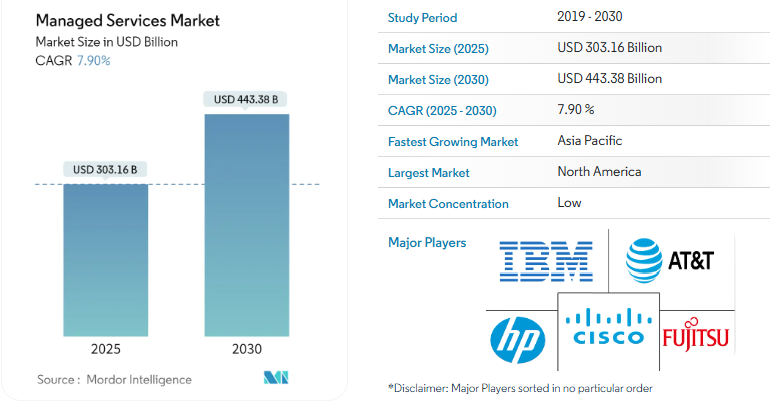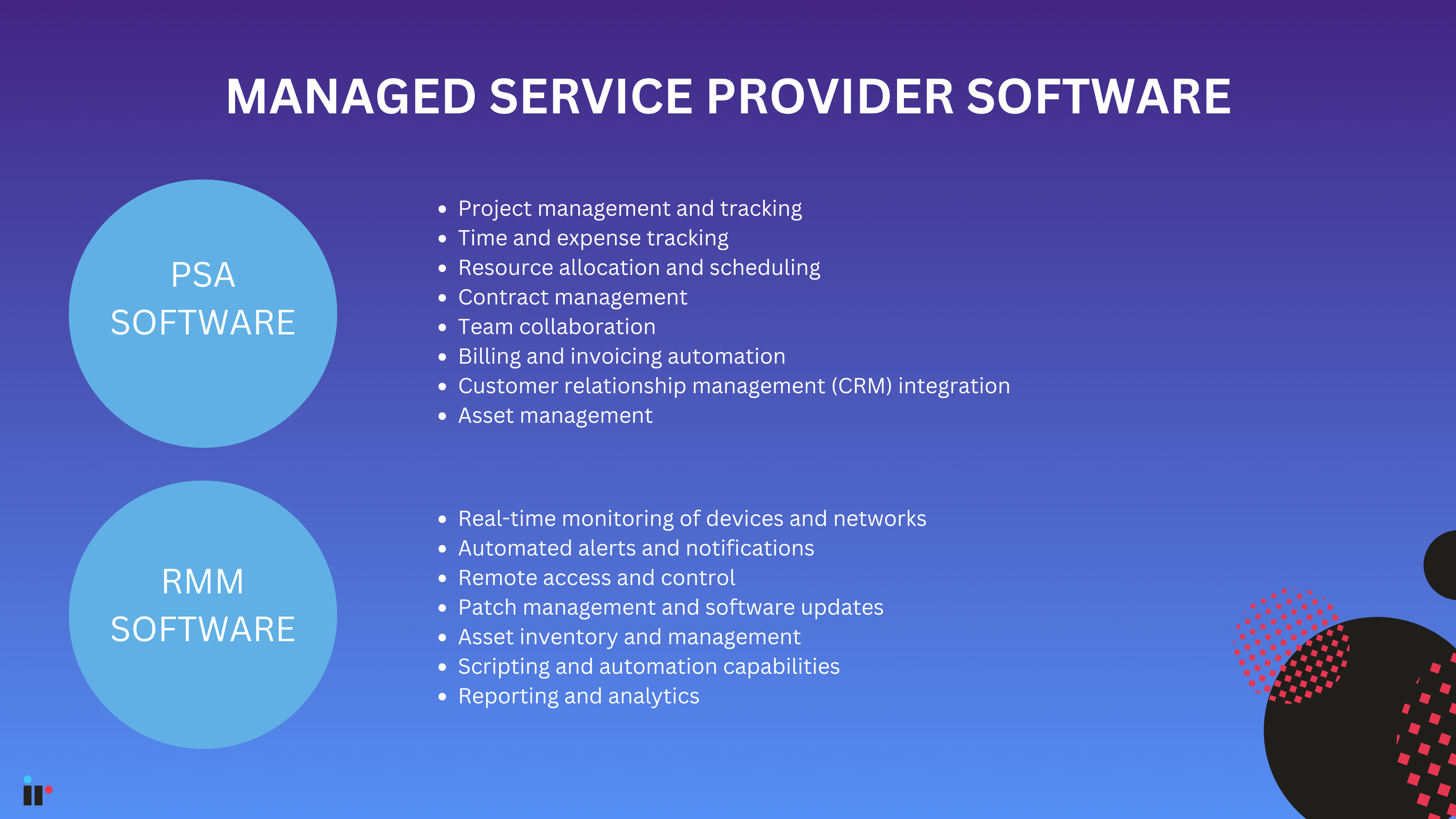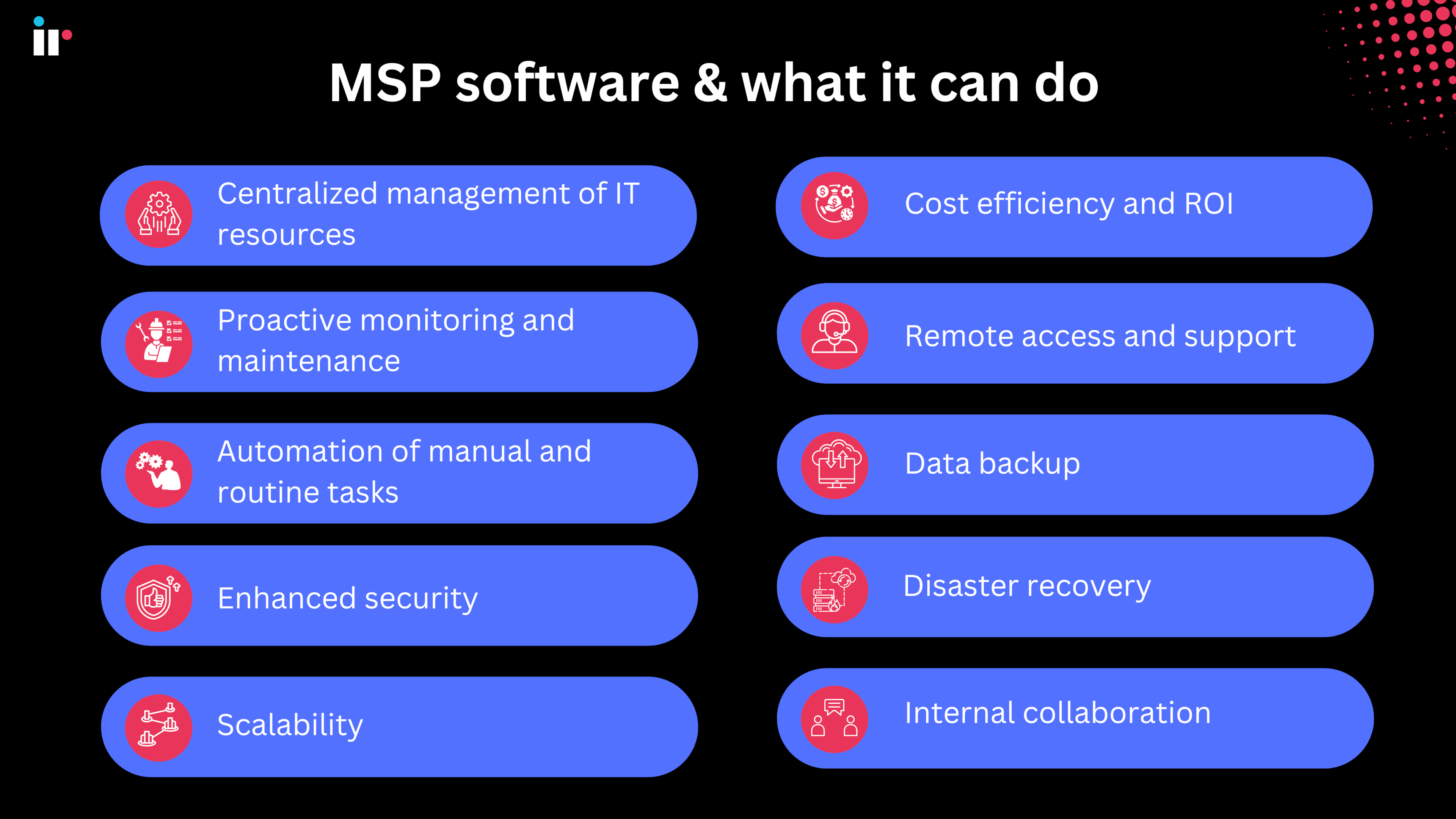Every enterprise organization wants to streamline their operations and improve efficiency.
To do this, and to ensure business continuity, organizations need to have comprehensive infrastructure management and monitoring in place that can provide robust security capabilities, oversee complex networks and implement proactive incident management strategies.
Today's highly advanced IT service management tools, or what we'll refer to as MSP software, allows managed service providers to maintain service levels from a single location, providing an integrated view of multiple client networks. This alleviates the need to use separate tools for each client.
Managed Service Provider software (MSP software) is the answer to the growing dilemma of overworked in-house IT departments finding it more and more difficult in today's working environment, to deliver effective technical support.
Managed services have increased in popularity as a way for businesses to streamline operations and improve efficiency, and managed service provider software is becoming a vital element of today's IT infrastructure.
MSP software is a foolproof solution for effective client management, and for keeping up with rapid advancements in technology as well as the growing complexities of cloud computing.
Managed service providers promote business growth, by managing the complex administrative tasks that cost businesses time and money. The best MSP software can:
-
Enhance service delivery processes to ensure customer satisfaction
-
Ensure seamless delivery on SLAs
-
Provide higher uptime
-
Help organizations deliver a superior quality of customer service
-
Improve operational efficiency
The managed services market size is expected to grow from USD 260.39 billion in 2023 to USD 380.83 billion by 2028. This represents a CAGR of 7.90% during the forecast period (2023-2028).

Image source: Mordor Intelligence
Professional Services Automation (PSA software) and Remote Monitoring (RMM software)
Time is valuable for enterprise organizations, so when MSPs have to deal with the management and health status of a client’s IT infrastructure, they need Professional Service Automation (PSA software) and Remote Monitoring and Management (RMM tools) to do their job efficiently.
While they both perform essential tasks, PSA software and RMM software serve different primary functions, and are both necessary and highly complementary to MSP efficiency. Leveraging both tools will maximize operational efficiency and service quality.
PSAs deal with business processes, administration, and client systems management, while RMMs handle the technical aspect of MSP work and maintaining an organization's IT infrastructure.
So these tools fall under the general description of managed service provider software, but what exactly are they and how can they improve an MSP's IT service business and benefit their clients?
In this comprehensive article, we'll look at the types of tools in an MSP's arsenal, and what MSP software solutions can do.
Are you delivering high-quality services?
Find out how IR Collaborate can help you confidently manage a growing customer base and exceed service expectations

Managed service provider (MSP) software overview
MSP software acts like a virtual assistant for business operations within any number of industries, such as B2B integration, transportation, information services, supply chain management, and utilities.
A managed service provider relies on MSP software to make administering IT services easier. This includes offering high quality product documentation, ease of navigation and ongoing technical support.
MSP software allows managed service providers to offer their clients a vast array of invaluable services and benefits within their IT environment. In general, the best MSP software provides:
-
Management of your cloud computing environment
-
Software as a service (SaaS)
-
Infrastructure as a service (IaaS)
-
XaaS (Everything / Anything as a Service)
-
Project management tools
-
Comprehensive infrastructure monitoring
-
Automated patch management
-
Managed wireless and mobile computing
-
Client data analytics
What MSP software can do
By incorporating both PSA and RMM solutions, IT service providers and MSPs have the upper hand in an increasingly complex and demanding market.
Combining streamlined business processes and proactive technical management enables a managed service provider to create a powerful foundation for business growth, client and customer satisfaction, and ultimately, long-term success.
Businesses who use managed service providers and deploy managed service software, can experience the benefits of increased efficiency and plenty of scale for growth. Proactive IT management with the use of remote desktop software can streamline tasks and create a far more efficient IT environment.
Let's break down some MSP software specific functions.
Find out more: Read our in-depth guide
Demystifying Remote Monitoring and Management (RMM) for Managed Service Providers
Centralized management of IT resources
The best MSP software provides a centralized platform to monitor, manage, and support all IT systems and services across multiple locations, client devices, and cloud environments.
It ensures visibility into hardware, software, networks, and user endpoints from a single platform, simplifying administration and providing endpoint protection.
Proactive monitoring and maintenance
Every organization's IT environment is different, but proactive monitoring with Remote Monitoring and Management software means that a managed service provider can help every business to detect and address issues before they escalate into major problems and end up causing costly downtime.
Reactive troubleshooting, or a 'firefighting strategy' usually means something is already on fire. Rectifying errors after they have already occurred, almost always affects your users, and this approach to IT management is no longer enough to ensure success in the business world.
Automation of manual and routine tasks
Automation wherever possible is one of the key ways to save time, money and resources. MSP software automates the types of important tasks that need to be done regularly, but tend to drain IT resources, like patch management, backups, updates, and reporting.
Automation also reduces human error by eliminating excessive manual input so it not only saves time, but allows IT teams to focus on strategic initiatives.
Enhanced security
Cybersecurity is a growing concern for large and small businesses. MSP tools includes features like threat detection, custom alerts, endpoint security, and compliance management.
MSP security software ensures businesses remain protected against evolving threats while meeting regulatory requirements.
Scalability
As businesses grow, managing the infrastructure of an organization's IT stack becomes more complex. MSP software solutions allow companies to scale their IT services efficiently so that they can grow without needing a proportional increase in staff or resources. Some businesses may experience seasonal fluctuations, and MSPs can quickly adjust resources and services to align with the company’s requirements.
This flexibility allows companies to maintain operational efficiency without overcommitting to resources or retaining unnecessary ones - or underestimating needs.
Cost efficiency and ROI
Instead of investing in expensive infrastructure, software and full-time IT staff, organizations can leverage MSP resources and expertise at a fraction of the cost. MSP software reduces operational costs by streamlining IT processes, alleviating the need for on-site visits, and optimizing resource allocation.
Remote access and support
In today's growing remote working culture, MSP software provides tools for remote desktop management, ensuring businesses can support any number of users no matter where they're located, without physical presence.
Data backup and disaster recovery
MSP software includes integrated backup software and disaster recovery solutions, and this ensures that critical business data is protected and recoverable in case of incidents like ransomware, cyberattacks or hardware failure.
Client data loss can have a severe and destructive impact on enterprise organizations. Data can be destroyed, corrupted, or made unreadable by software applications and users either accidentally or intentionally.
Human error is seen as the primary cause of most data loss in business. Other causes include hardware theft, software corruption, computer viruses, hardware impairment, natural disasters, and power failure.
A good backup system is part of an MSP's arsenal of software solutions and is the most efficient solution to data loss, as it increases the chances of data recovery.
Internal collaboration
MSP software can enable smooth communication between your team members, and serves as a vital element in ensuring an effective service to your clients. A collaboration interface helps service desk agents avoid mundane tasks and keeps them informed about any issues that other agents may have.

Key functions of PSA software
As previously mentioned, PSA solutions are part of the collection of MSP software tools that streamline the aspects of work that aren’t the actual IT development and monitoring work. For example, this can cover sales, project management, and billing.
A PSA platform collates these individual areas into a single platform so they can be monitored, maintained and organized. These include:
-
Project management and tracking
-
Time and expense tracking
-
Resource allocation and scheduling
-
Contract management
-
Team collaboration
-
Billing and invoicing automation
-
Customer relationship management (CRM) integration
-
Reporting and analytics
-
Asset management
What to look for in PSA solutions
Most PSA software functionality overlaps between tools, but each platform usually has a few key features that differ from others.
Intuitive user interface
An intuitive user interface that's consistent across all applications requires minimal training for users, as well as relieving IT headaches. Different interfaces can make one feature more straightforward to use than another, so prioritizing what is most important and then finding a UI that improves that function can ease administrative burdens.
Integration capabilities
PSA tools should integrate seamlessly with your existing tools, especially your RMM software. If the IT team already uses some built-in tools, try to identify gaps, and if PSA can integrate with that platform. Otherwise choose a PSA that can replace that functionality without disrupting workflows.
Project management
Assess what features and level of detail are available in the software for project management, and determine how resource management integrates with the project management portion. Doing this homework will identify what functionality is best for each MSP.
Client portal
Help desk tools are essential to ensure MSP offerings satisfy their clients' needs. Some PSAs offer service desk options, ticketing management, and client relations features. It can also allow clients to log in and review help desk documents and materials. First, review the existing features to determine if new features are beneficial.
Key functions of RMM software
RMM solutions are the other important part of MSP software that focus on adding overall efficiency to the service delivery side of an MSP business. RMM solutions do this through data-driven insights and proactive issue resolution.
RMM tools assist with the creation and delivery of IT service operations, allowing IT professionals to engage with the client’s network infrastructure and gain real-time insights into its health and performance, providing:
-
Real-time monitoring of devices and networks
-
Automated alerts and notifications
-
Remote access and control
-
Patch management and software updates
-
Asset inventory and management
-
Scripting and automation capabilities
-
Reporting and analytics
Features to look for in RMM software
RMMs help improve internal technical processes while keeping labor costs down. All RMMs should provide the basic required functionality, such as connecting remotely to a client’s server, notifying IT professionals of system statuses, and proactively handling issues. Other features include:
Automated remediation
Most RMM software automatically resolves common issues within client networks, and automates patches without manual IT personnel involvement. It should be able to resolve issues quickly through early detection as well as automate and schedule maintenance tasks to maintain system health.
Security features
RMM solutions should be able to run security patches and install updates with built-in security features like antivirus management, firewall management, and encryption. A robust suite of these features could even alleviate the need for an additional cybersecurity platform.
Remote access
RMM tools should always have the capabilities to remotely access client networks for efficient troubleshooting. Remote features extend to the client management side of identifying, diagnosing and fixing issues, such as facilitating chat, video meetings, pinpointing issues with mobile devices, and screen-sharing functionality.
Integration support
MSPs often use particular platforms for certain nuanced issues, but to operate effectively, all tools and solutions must be well integrated with client devices and applications, otherwise it could result in the creation of silos and manual processes - and a negative impact on customer service. RMM should integrate seamlessly with essential tools, making all tasks easier to manage.
Third-party monitoring tools play a significant role in medium term cost optimization and releasing resources for strategic value creation. Utilization and adoption reports, and the detailed data and analytics provided by monitoring tools will help organizations to make the necessary decisions to achieve digital acceleration.
Summary of the benefits of MSP software solutions
Using a strategic mix of PSA and RMM solutions, MSPs have everything they need to effectively manage, monitor and maintain various organizations' IT operations.
-
PSAs deal with business processes, administration, and client systems management, while RMMs handle the technical aspect of MSP work and maintaining an organization's IT infrastructure.
-
PSA tools streamline the aspects of work that aren’t the actual IT development and monitoring work, such as billing and invoicing automation, CRM integration, asset and contract management and team collaboration.
-
Remote monitoring and management tools enable proactive monitoring and resolution of issues with devices and networks in real time, software updates, alert management, reporting and analytics.
How MSP software solutions benefit organizations
-
Cost savings: Billing, procurement, and delivery can all be consolidated in one system without the expense of purchasing multiple systems.
-
Less overhead: An increase in speed and accuracy while reducing the need for more team members.
-
Improved customer satisfaction: Managed service software increases accuracy, provides better billing visibility, and faster delivery.
-
Increased growth and profitability: An MSP platform can deliver new services and create new markets to accelerate growth and profit.
-
Better operational efficiency: MSP software with automation helps to streamline and accelerate business processes.
-
Secure endpoint management: Including hardware or software endpoints, networks, mobile devices and computers.
-
Improved visibility: MSP software can improve the visibility into client machines, enabling a quicker response to threats, and streamlining tasks.
IR Collaborate for service providers can help deliver deep insights, comprehensive visibility, and customer-specific reports. This adds more value, and helps you confidently meet SLAs, with the evidence to back it up, and improve customer onboarding and management.
How IR can simplify complexity for Service Providers
IR Collaborate for service providers can help deliver deep insights, comprehensive visibility, and customer-specific reports in one complete solution across hybrid cloud and multi-vendor environments.
This added value helps you meet SLAs with confidence, and the evidence to back it up, and improve customer onboarding and management.
Multi-tenant support
Leverage secure, API-driven access to multiple clients environments in a single application.
End-to-end insight
Be proactive in service delivery by leveraging real-time insights through end-to-end visibility across hybrid, multi-vendor, multi-tenant ecosystems.
Meet SLAs with ease
Guarantee customer satisfaction and deliver on SLAs, with high uptime, a superior quality of service, and the reporting and evidence to back it up.
Multi-vendor support
Support for Microsoft, Cisco, Zoom and Avaya UC platforms, ServiceNow Service Management platform, and numerous SBC and device vendors.
Improve customer onboarding and management
Faster customer onboarding with streamlined deployment models, better performance visibility and deep insights into your environment.
IR Collaborate can help you simplify the complexity of managing multiple tenants and technologies, giving you the comprehensive insight you need to deliver exceptional service and stay ahead of the competition.
Learn more about our support for Service Providers



